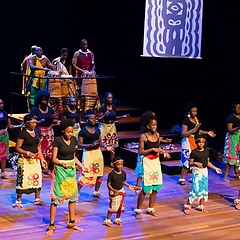Tambu is a collective name for various elements of a tradition that originates from the Netherlands Antilles and is now maintained also in the Netherlands. Tambu is primarily the name of a drum. Making a tambu belongs to the tradition. Furthermore Tambu is also the name of the music genre, the dance, the associated singing and the feast during which these elements are performed. There are, however, different elements in the Tambu on the various islands. The tambu as a major instrument is accompanied by music made with a wiri, a chapi, an agan and a triangle. On these metal instruments, often parts of agricultural tools, the rhythm is struck with a metal stick. Bystanders accompany the dance by clapping their hands. Moreover, there is a male of female lead singer and a choir that answers to what is sung, or repeats it. On the Antilles, Tambu is often celebrated in between Christmas and New Year’s Eve. In the Netherlands Tambu-evenings are organised throughout the year in Rotterdam.



